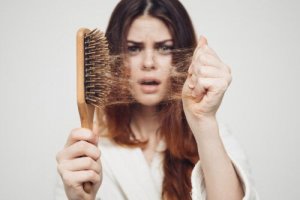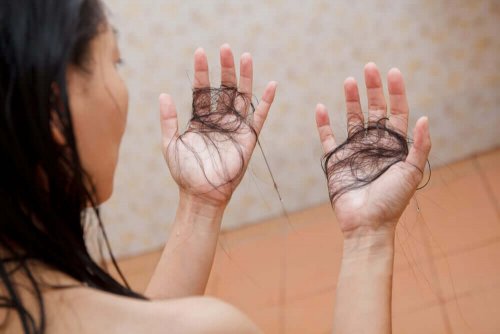Seasonal Hair Loss: Why Does It Happen in the Fall?

Did you know that seasonal hair loss is more common during the fall? However, it shouldn’t be a source of concern. It’s perfectly normal for it to happen. Just like with the leaves of the trees, our hair undergoes a process of renewal in the fall.
If you lose more hair during the fall, it’s probably because it’s part of the heritage we have from our mammalian ancestors. In fact, all mammals lose part of our hair during this season. Then, everything goes back to normal once it’s over.
The process by which we lose more hair during the fall is called “seasonal hair loss.” It affects all people, but it’s those with long hair who notice it most. Some people get concerned when it happens and try to get more vitamins and other supplements. However, this is neither necessary nor effective.
Seasonal hair loss

Regardless of the season, all human beings – both male and female – lose hair continuously. Under normal conditions, between 12 and 15% of our hair renews each day. Thus, we lose about 80 to 100 hairs per day.
What this means is that we renew our entire hair in four years. However, there are times when the loss is greater. This is usually during the fall, although it isn’t unusual for it to also happen during the spring.
This process of renewal has only one exception: newborns. Babies are born with a sort of fluff that goes away completely after their third or fourth month of life. This is when their real hair begins to grow.
What causes seasonal hair loss?
In principle, all mammals are evolutionarily conditioned to change their fur in preparation for winter. This is because cold weather demands renewed hair that can cope with low temperatures. Thus, this is the first reason why we lose more hair during the fall.
Likewise, hair loss is part of a natural physiological renewal process and has a seasonal factor. For instance, the hair usually dies in spring, but it takes up to three months to go away, which just so happens to coincide with the fall. That is why hair loss peaks during this season.
Similarly, the variation of light and the number of hours of sunshine also influence hair loss. Overall, these factors lead to a variation in the secretion of melatonin and prolactin. The consequence is a change in the hair’s telogen effluvium content, which leads to shedding.
Read on: Hair Loss Prevention – Five Tips for a Healthy Scalp
Myths and facts

There are some seasonal hair loss myths. For example, some say it affects women more than men. However, this isn’t true. What happens is that women usually have longer hair and therefore notice it more.
Others say that you have to brush the softest hair to prevent hair loss or that the shedding will stop if you don’t braid it. Both statements are false, as the hair comes off because it’s already practically loose. Any hair that isn’t a part of this shedding process has a root of about 1/4 inch below the scalp. Thus, it’s very difficult to pull it off.
Then some claim that taking a vitamin supplement prevents hair loss during the fall. However, this is also false. This is because this process doesn’t happen due to a vitamin deficiency but to a completely natural physiological change.
Discover more:Ten Reasons that Might Explain Your Hair Loss
When to worry about hair loss
So, let’s be clear: seasonal hair loss isn’t a really a loss, but a renewal. The hair we lose during the fall grows back in about three to four months all by itself. Thus, there’s no need for treatment or changes in our routine. When a hair comes off, it’s only because there’s already another one pushing it out.
The best course of action is to wash your hair frequently and brush it daily. This way, it’ll gradually come off. This is because if you only brush from time to time, there’ll be accumulated loose hair in your head and you’ll have the impression that you’re losing a lot more than you should.
Finally, hair loss during the fall should only be of concern if it’s truly extreme or if you continue to lose it after the season is over. In these extreme cases, it’s always a good idea to go to a dermatologist who can better assess the situation.
All cited sources were thoroughly reviewed by our team to ensure their quality, reliability, currency, and validity. The bibliography of this article was considered reliable and of academic or scientific accuracy.
Guerrero, A. R., & Ch, M. K. (2011). Alopecias. Revista Médica Clínica Las Condes, 22(6), 775-783.
This text is provided for informational purposes only and does not replace consultation with a professional. If in doubt, consult your specialist.








